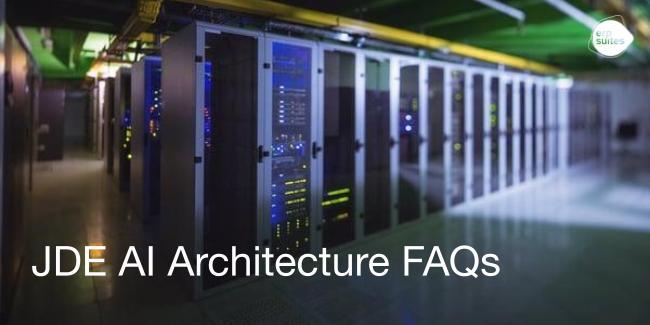How AI Is Making JD Edwards Smarter: Real Use Cases from ERP Suites
June 10th, 2025
3 min read
In this episode of "Not Your Grandpa’s JD Edwards," host Nate Bushfield speaks with Manuel Neyra, VP of AI and Products at ERP Suites, about leveraging artificial intelligence to transform JD Edwards from a transactional ERP into a proactive, intelligent enterprise system. They discuss practical steps for businesses to prepare for AI adoption, the importance of data readiness, and specific AI solutions—including document understanding, digital sales assistants, and anomaly detection—that significantly enhance productivity and profitability. By the end of this episode, listeners will have a clear understanding of how to move their JD Edwards ERP beyond basic data entry to unlock deeper insights and strategic advantages.
Table of Contents
-
Introduction: Rethinking JD Edwards ERP
-
Why JD Edwards Has Historically Been Transactional
-
Obstacles to AI Adoption in JD Edwards
-
Knowing When Your ERP is AI-Ready
-
The Four-Phase AI Journey Roadmap
-
Importance of Security and Data Governance
-
Managing Change During AI Implementation
-
Real AI Solutions in Action
-
The Power of Digital Sales Assistants
-
AI’s Role in Identifying and Resolving Issues
-
Next Steps: Starting Your AI Journey
Transcript
Introduction: Rethinking JD Edwards ERP
Is your JD Edwards system just a data-entry machine? What if it could actually help your business think, optimize, forecast, spot pricing gaps, and even prevent downtime?
In this episode of "Not Your Grandpa’s JD Edwards," I talk with Manuel Neira from ERP Suites about how AI and orchestrator are transforming JD Edwards from a transactional system into a smart, self-improving enterprise engine. Stick with us—you'll walk away knowing how to prep your organization and data for the next big leap in ERP.
Why JD Edwards Has Historically Been Transactional
Most companies are still using JD Edwards primarily for data entry. Manuel, why do you think JD Edwards has traditionally been seen this way?
The legacy of ERP systems like JD Edwards started as transactional systems, originally designed for accounting data entry. Over time, ERP expanded into operational areas, but old perceptions still linger. Many companies also invested in ancillary systems, reinforcing the idea that ERP is strictly transactional.
Obstacles to AI Adoption in JD Edwards
What’s holding organizations back from evolving JD Edwards into something smarter and more autonomous?
Lack of awareness is a key issue. Many companies misunderstand AI, equating it with consumer-level tools like ChatGPT, and are uncertain about using AI for enterprise-critical tasks. Enterprise AI requires a deeper understanding and stronger foundations.
Knowing When Your ERP is AI-Ready
How will companies know when their JD Edwards ERP is ready for AI?
Companies must first align strategically, ensuring leadership buy-in and clearly defined AI policies. Then they must assess their data quality, security, compliance, and operational readiness. Small, focused AI initiatives can also help validate readiness quickly.
The Four-Phase AI Journey Roadmap
Can you walk us through the four-phase AI journey roadmap from your recent SKUG presentation?
-
Alignment Day: Engage leadership, confirm AI strategy and assess readiness.
-
Assessment Phase: Evaluate data quality, security, compliance, and identify suitable AI use cases.
-
Cleanse and Optimize Phase: Address data issues and ensure optimal readiness for AI implementation.
-
Implementation Phase: Develop and launch AI solutions on a strong data and security foundation.
Quick wins are possible too, providing immediate value and proof of concept.
Importance of Security and Data Governance
How important is security and data governance in the early phases of AI adoption?
Extremely important. AI capabilities are powerful, but without proper security and compliance, risks can outweigh benefits. Enterprise AI must have controlled access and robust governance built-in from the start.
Managing Change During AI Implementation
How important is change management when introducing AI into longstanding processes and teams?
Critical. The technological shift toward AI can create uncertainty and fear among teams. Effective change management means preparing teams to work collaboratively with AI—not replacing them, but enhancing their roles. Businesses that fail to manage change risk falling behind competitors who successfully adopt AI.
Real AI Solutions in Action
Can you break down the automated Quote-to-Order solution that ERP Suites has developed?
This solution uses AI-based document understanding integrated into JD Edwards Orchestrator, significantly streamlining the quote-to-order process. AI reads incoming documents, extracts key information automatically, and optimizes quotes quickly. This approach drastically reduces processing time and increases conversion rates.
The Power of Digital Sales Assistants
How does the Digital Sales Assistant integrate with JD Edwards workflows, and what value does it add?
The Digital Sales Assistant supports customer service representatives by providing advanced cross-sell/up-sell recommendations and streamlining the order approval process. It enhances user productivity, helps new employees ramp up faster, and updates JD Edwards data in real-time, seamlessly integrating AI into daily workflows.
AI’s Role in Identifying and Resolving Issues
How is AI not only identifying issues but actively fixing and flagging them in JD Edwards?
AI uses pattern recognition to detect anomalies in both business processes and technical operations. It identifies outdated or problematic patterns, suggests proactive solutions, and can even self-heal certain issues—transforming JD Edwards into a smarter, more resilient ERP.
Next Steps: Starting Your AI Journey
If your business wants to take JD Edwards beyond simple data entry, now is the time to start. Visit ERP Suites at ERP.Suites.com to learn about our AI assessment process or connect directly with Manuel and his team to begin your journey.
That’s a wrap for today’s "Not Your Grandpa’s JD Edwards." Huge thanks to Manuel for showing us how AI is not only possible inside JD Edwards—it’s already happening. If you found value, subscribe, leave a review, or share this with someone who still thinks AI is science fiction.
Until next time, keep modernizing, keep innovating, and keep making JD Edwards just damn efficient. Thank you.
Video Strategist at ERP Suites
Topics:


